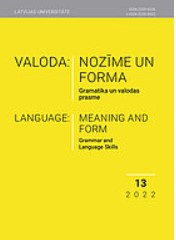Grieķu un latviešu leksisko elementu secība Tetraevaņģēlijā
The order of Greek and Latvian lexical elements in the Tetraevangelion
Author(s): Dens DimiņšSubject(s): Syntax, Lexis, Comparative Linguistics, Baltic Languages, Biblical studies, Translation Studies, Rhetoric
Published by: Latvijas Universitātes Akadēmiskais apgāds
Keywords: word order; contacts of languages; rhetoric; information status; focus; ordering of constituents with the clause;
Summary/Abstract: This diachronic and contrastive study briefly outlines the trends of the ordering of lexical items in Greek Koine and Latvian, focusing on the four Gospels of the New Testament and four translations thereof into Latvian, spanning the 18th–21st century. The language of the Bible has had a lasting influence on the formation of the Latvian literary language. The word order in Latvian and Greek is relatively free, however, it is possible to note certain trends, to wit, 1) at the level of certain parts of speech where there are words with a fixed position, either postpositives or prepositives; 2) placement of words in Noun Phrases; as well as 3) the ordering of constituents within the clause where the order depends on the information status, i.e., on whether it is presupposed or asserted, and on the presence of particular syntactic constructions. In terms of word order, it appears that the oldest Latvian translation of the Bible is closer to the Koine original, albeit at times it also shows some German influence.
Journal: Valoda: nozīme un forma
- Issue Year: 2022
- Issue No: 13
- Page Range: 91-104
- Page Count: 14
- Language: Latvian

